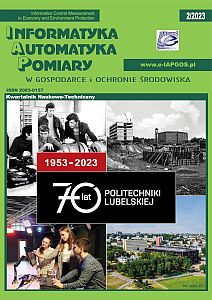Abdrabboh M. A.: Studies in Heat and Mass Transfer in Oil Sand Beds. Ph.D. thesis. University of Calgary, Calgary, Alberta, Canada,1983.
Abimbola A., Bright S.: Alternating-Direction Implicit Finite-Difference Method for Transient 2D Heat Transfer in a Metal Bar using Finite Difference Method. International Journal of Scientific & Engineering Research 6(6), 2015.
DOI: https://doi.org/10.14299/ijser.2015.06.013
Altybay A. et al.: Software Application for the Investigation of the Wave Propagation in 1d and 2d Wave Equations with Singular Coefficients. Telematique 21(1), 2022, 7468–7474.
Anderson D. A. et al.: Computational Fluid Mechanics and Heat Transfer. 2nd ed., Taylor & Francis, 1977.
Badrul I.: Petroleum sludge, its treatment and disposal: a review. Int. J. Chem. Sci. 13(4), 2015, 1584–1602.
Balakayeva G. et al: Digitalization of enterprise with ensuring stability and reliability. Informatics, Control, Measurement in Economy and Environmental Protection 13(1), 2023, 54–57 [http://doi.org/10.35784/iapgos.3295].
DOI: https://doi.org/10.35784/iapgos.3295
Balakayeva G., Darkenbayev D.: The solution to the problem of processing big data using the example of assessing the solvency of borrowers. Journal of Theoretical and Applied Information Technology 98(13), 2020, 2659–2670.
Balakayeva G. T. et al.: Numerical modeling of heat and mass transfer in a reactor for continuous movement of oxidation of oil slime. Chemical Bulletin of Kazakh National University 3, 2000, 47–55.
Balakayeva G.T. et all: Using NoSQL for processing unstructured BigData, News of the Republic of Kazakhstan series of Geology and Technical sciences 6(438), 2019, 12–21.
DOI: https://doi.org/10.32014/2019.2518-170X.151
Chang M. J. et al.: Improved alternating-direction implicit method for solving transient three-dimensional heat diffusion problems. Numerical Heat Transfer, Part B: Fundamentals, 1991, 69–84.
DOI: https://doi.org/10.1080/10407799108944957
Dash User Guide, 2022 [https://dash.plotly.com].
Dong X. et al.: Treatment of layered oily sludge by a thermal steam process. 13th International Conference on Waste Management and Technology (ICWMT 13), Beijing, China, 2018.
Egazaryants S. V. et al.: Oil slime Treatment Processes. Chemistry and Technology of Fuels and Oils 5(51), 2015, 506–515.
DOI: https://doi.org/10.1007/s10553-015-0632-7
Hanafi A. S.: Experimental and Analytical Studies of Volatilization and Burning of Oil Sand Particles. Ph.D. thesis, The University of Calgary, Calgary, Alberta, Canada, 1979.
Hu G. et al.: Recent development in the treatment of oil slime from petroleum industry. Journal of Hazardous Materials 2(61), 2014, 470–490.
DOI: https://doi.org/10.1016/j.jhazmat.2013.07.069
Jadidi N. et al.: The Most Recent Researches in Oily Sludge Remediation Process. Am. Journal of Oil and Chemical Technologies 2(10), 2019, 340–348.
Johnson O. A., Affam A. C.: Petroleum sludge treatment and disposal: A review. Environmental Engineering Research 24(2), 2019, 191–201 [http://doi.org/10.4491/eer.2018.134].
DOI: https://doi.org/10.4491/eer.2018.134
Kalmenova G. B., Balakayeva G. T.: Developing a model of oil slime processing. Bulletin of KazNTU. Series Physics and mathematics 3, 2019, 552–555.
Kunlong H. et al.: Status and prospect of oil recovery from oily sludge: A review. Arabian Journal of Chemistry 3(8), 2020, 6523–6543.
DOI: https://doi.org/10.1016/j.arabjc.2020.06.009
Lubanovic B.: Introducing Python: Modern Computing in Simple Packages 2nd Edition. O'Reilly Media, 2019.
Ma Z. et al.: Modeling and Simulation of Oil slime Pyrolysis in a Rotary Kiln with a Solid Heat Carrier: Considering the Particle Motion and Reaction Kinetics. Energy & Fuels 28(9), 2014, 6029–6037 [http://doi:10.1021/ef501263m].
DOI: https://doi.org/10.1021/ef501263m
Norzilah A. H., Nursalasawati R.: Alternating Direction Implicit (ADI) Method for Solving Two Dimensional (2-D) Transient Heat Equation. ASM Sci. J., Special for SKSM 26(6), 2019, 28–33.
Python interface to Tcl/Tk, Python Documentation, 2019 [https://docs.python.org/3/library/tkinter.html].
Romano F. et al.: Learn Web Development with Python//Packt Publishing Ltd, 2018.
Shan Z.: A Matched, Alternating Direction Implicit (ADI) Method for Solving the Heat Equation with Interfaces. Journal of Scientific Computing 63(1), 2015, 118–137.
DOI: https://doi.org/10.1007/s10915-014-9887-0
Yao W.: Research and application of oil slime resource utilization technology in the oil field. IOP Conference Series Earth and Environmental Science 170(3), 2018 [http://doi:10.1088/1755-1315/170/3/032026].
DOI: https://doi.org/10.1088/1755-1315/170/3/032026
Zhang X. et al.: Thermal Desorption Process Simulation and Effect Prediction of Oil-Based Cuttings. ACS Omega 7(25), 2022, 21675–21683 [http://doi:10.1021/acsomega.2c01597].
DOI: https://doi.org/10.1021/acsomega.2c01597
Ziyi W. et al.: Application and development of pyrolysis technology in petroleum oily sludge treatment. Environmental Engineering Research 26(1), 2021 [http://doi.org/10.4491/eer.2019.460].
DOI: https://doi.org/10.4491/eer.2019.460







